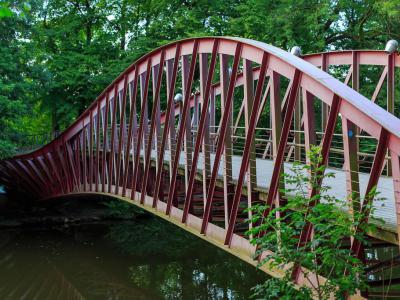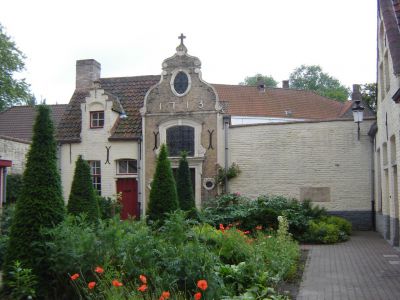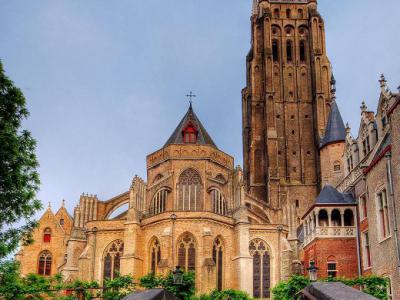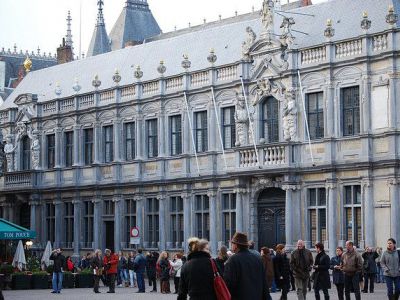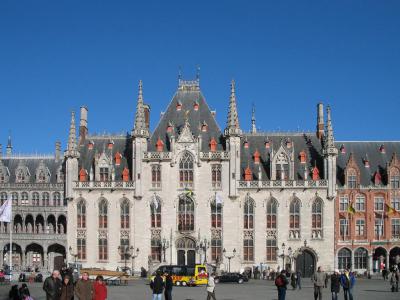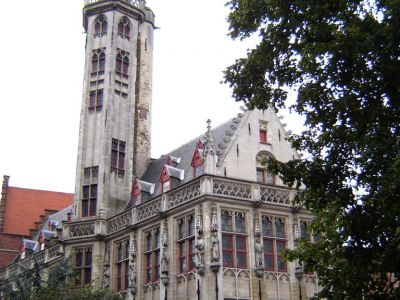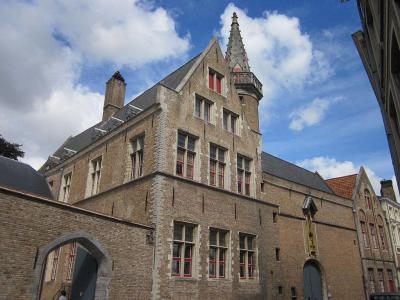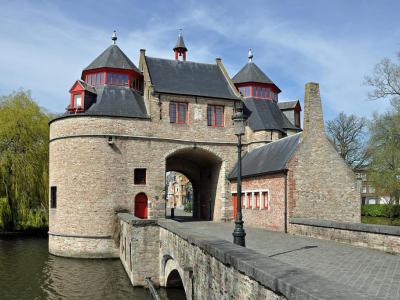Architectural Jewels Walking Tour (Self Guided), Brugge
Within its egg-shaped boundary, the historic town of Brugge holds a wealth of architectural treasures. Both medieval and more modern creations await you practically around every corner and are fit to enchant even the most discerning viewers.
One such is a splendid piece of engineering called the Barge Bridge (Bargebrug). Its bright red and asymmetrical form makes it a charming spot and photo op.
Another notable landmark is the De Vos Almshouse, a medieval charity complex built in the 15th century. Its distinctive façade showcases the Flemish Renaissance style, and the courtyard within offers a tranquil escape from the bustling streets.
The Church of Our Lady is an iconic symbol of Brugge, known for its towering spire that dominates the skyline. This Gothic masterpiece houses Michelangelo's Madonna and Child sculpture, adding to its allure.
The Provost's House, further ahead, is a remarkable piece of Baroque, whose grandeur reflects the historical significance of the clergy in Brugge's past.
The Provincial Court (Provinciaal Hof), in turn, is a Neo-Gothic marvel and seat of the provincial government. Its stunning façade and intricate detailing make it a must-see for architecture buffs.
You can't pass without noticing the eye-catching Burgher's Lodge (or Poortersloge) either. Once a meeting place for the city's commercial elite, today it serves as an exhibition space for contemporary art.
The medieval mansion of Hof Bladelin exudes elegance and history. Its interior courtyard and Gothic features are a visual delight.
Finally, the Ezelpoort, or Donkey's Gate, is a medieval city gate that transports you back in time as you pass through it.
Brugge's architectural jewels can leave you in awe regardless of whether you're an architecture enthusiast or just a casual visitor. So, don't miss the opportunity to explore them up close and get yourself a deep and lasting impression of the city's beauty.
One such is a splendid piece of engineering called the Barge Bridge (Bargebrug). Its bright red and asymmetrical form makes it a charming spot and photo op.
Another notable landmark is the De Vos Almshouse, a medieval charity complex built in the 15th century. Its distinctive façade showcases the Flemish Renaissance style, and the courtyard within offers a tranquil escape from the bustling streets.
The Church of Our Lady is an iconic symbol of Brugge, known for its towering spire that dominates the skyline. This Gothic masterpiece houses Michelangelo's Madonna and Child sculpture, adding to its allure.
The Provost's House, further ahead, is a remarkable piece of Baroque, whose grandeur reflects the historical significance of the clergy in Brugge's past.
The Provincial Court (Provinciaal Hof), in turn, is a Neo-Gothic marvel and seat of the provincial government. Its stunning façade and intricate detailing make it a must-see for architecture buffs.
You can't pass without noticing the eye-catching Burgher's Lodge (or Poortersloge) either. Once a meeting place for the city's commercial elite, today it serves as an exhibition space for contemporary art.
The medieval mansion of Hof Bladelin exudes elegance and history. Its interior courtyard and Gothic features are a visual delight.
Finally, the Ezelpoort, or Donkey's Gate, is a medieval city gate that transports you back in time as you pass through it.
Brugge's architectural jewels can leave you in awe regardless of whether you're an architecture enthusiast or just a casual visitor. So, don't miss the opportunity to explore them up close and get yourself a deep and lasting impression of the city's beauty.
How it works: Download the app "GPSmyCity: Walks in 1K+ Cities" from Apple App Store or Google Play Store to your mobile phone or tablet. The app turns your mobile device into a personal tour guide and its built-in GPS navigation functions guide you from one tour stop to next. The app works offline, so no data plan is needed when traveling abroad.
Architectural Jewels Walking Tour Map
Guide Name: Architectural Jewels Walking Tour
Guide Location: Belgium » Brugge (See other walking tours in Brugge)
Guide Type: Self-guided Walking Tour (Sightseeing)
# of Attractions: 8
Tour Duration: 2 Hour(s)
Travel Distance: 3.0 Km or 1.9 Miles
Author: HelenF
Sight(s) Featured in This Guide:
Guide Location: Belgium » Brugge (See other walking tours in Brugge)
Guide Type: Self-guided Walking Tour (Sightseeing)
# of Attractions: 8
Tour Duration: 2 Hour(s)
Travel Distance: 3.0 Km or 1.9 Miles
Author: HelenF
Sight(s) Featured in This Guide:
- Bargebrug (Barge Bridge)
- De Vos Almshouse
- Church of Our Lady
- Provost's House
- Provinciaal Hof
- Poortersloge (Burgher's Lodge)
- Hof Bladelin
- Ezelpoort
1) Bargebrug (Barge Bridge)
The Bargebrug (Barge Bridge) in Bruges is a modern architectural marvel that connects the serene Minnewater Park with the bustling Barge Square. This contemporary structure stands out with its vivid red color, forming a striking contrast against the lush green backdrop of the surrounding parkland. Asymmetric in design, the bridge showcases curved lines that elegantly pop against its environment, making it a must-see on any stroll along the City Ramparts.
Designed during a significant period in Bruges's history, when the city was celebrated as the Cultural Capital of Europe in 2002, the Bargebrug was part of a larger urban development project. The city council aimed to enhance Kanaaleiland, providing quality access to the city for visitors, particularly those arriving by bus. This initiative led to the creation of not only the bridge but also a well-integrated parking plaza complete with reception facilities, all designed by the same architect in a coherent style.
The bridge's design is both functional and symbolic, featuring a parapet that starts vertically but opens up as it nears the inner city. This dynamic curvature is not just an aesthetic choice but also a practical solution to bridge the height difference between the lower-situated Bargeplein and the City Ramparts. Today, the bridge serves as a gateway to Bruges, drawing visitors to the iconic Lake of Love Park and the nearby Beguinage, and stands as a testament to the city's commitment to blending functionality with striking modern design.
Designed during a significant period in Bruges's history, when the city was celebrated as the Cultural Capital of Europe in 2002, the Bargebrug was part of a larger urban development project. The city council aimed to enhance Kanaaleiland, providing quality access to the city for visitors, particularly those arriving by bus. This initiative led to the creation of not only the bridge but also a well-integrated parking plaza complete with reception facilities, all designed by the same architect in a coherent style.
The bridge's design is both functional and symbolic, featuring a parapet that starts vertically but opens up as it nears the inner city. This dynamic curvature is not just an aesthetic choice but also a practical solution to bridge the height difference between the lower-situated Bargeplein and the City Ramparts. Today, the bridge serves as a gateway to Bruges, drawing visitors to the iconic Lake of Love Park and the nearby Beguinage, and stands as a testament to the city's commitment to blending functionality with striking modern design.
2) De Vos Almshouse
The De Vos Almshouse consists of a group of houses for the poor, widows and the elderly. It is one of the 46 almshouses, or Godshuizen, in the center of Bruges.
The De Vos Almshouse was founded by Adriane de Vos, a wealthy and philanthropic merchant of Bruges. It was founded in 1480 and built, at the time, near the city wall and the Beguinage. Each house was assigned by a specific organization, like a hospital or a guild, e.g. the cooper’s or mason’s guild, with a view to benefit their elderly or poor members.
The De Vos Almshouse consisted of a complex of eight houses with an inner courtyard. The residents pumped water from a well in the courtyard and grew vegetables in small gardens in front of their houses. Like all almshouses in Bruges, the De Vos Godshuizen has a chapel where the residents were expected to pray for the soul of their benefactor. The houses have a white façade with the name of Adriane de Vos painted on it. The windows do not face the street because a tax was levied for each street facing window.
Today, the city owns the almshouse and has converted the complex into six houses for the residence of elderly citizens. It is managed by the social service department of the government. Visitors are not admitted inside but the quaint complex can be seen over a low wall.
The De Vos Almshouse was founded by Adriane de Vos, a wealthy and philanthropic merchant of Bruges. It was founded in 1480 and built, at the time, near the city wall and the Beguinage. Each house was assigned by a specific organization, like a hospital or a guild, e.g. the cooper’s or mason’s guild, with a view to benefit their elderly or poor members.
The De Vos Almshouse consisted of a complex of eight houses with an inner courtyard. The residents pumped water from a well in the courtyard and grew vegetables in small gardens in front of their houses. Like all almshouses in Bruges, the De Vos Godshuizen has a chapel where the residents were expected to pray for the soul of their benefactor. The houses have a white façade with the name of Adriane de Vos painted on it. The windows do not face the street because a tax was levied for each street facing window.
Today, the city owns the almshouse and has converted the complex into six houses for the residence of elderly citizens. It is managed by the social service department of the government. Visitors are not admitted inside but the quaint complex can be seen over a low wall.
3) Church of Our Lady (must see)
The Church of Our Lady is a stunning example of Gothic architecture. The church dates back to the 13th century. The tower is 115.6 meters (379 feet) tall and is the tallest structure in Brugge. The impressive tower is the third tallest brickwork tower in the world.
The exterior flying buttresses were built in the 13th century. The interior side aisles and chancel feature ornate Baroque style.
Several notable tombs are located behind the altar. Charles the Bold and his daughter Duchess Mary are interred here. The tombs feature gilded bronze effigies. Charles the Bold wears full armor. Both Charles and Mary are shown wearing crowns. Mary Lovel, the founder of a convent at Antwerp, is also buried here.
Michelangelo created a stunning white marble sculpture of the Madonna and Child around 1504. The sculpture was donated to the Church of Our Lady in 1514. This sculpture is the biggest attraction in the Church of Our Lady and is located in the large chapel known as the Cappella sacra.
The sculpture is notable on two fronts. First, it is the only Michelangelo artwork that left Italy during his lifetime. Second, instead of featuring a Modonna looking lovingly at her child, this interpretation shows Madonna's sorrow at what will happen to her son.
French revolutionaries looted the sculpture in 1794 as did the German Nazis in 1944. It was successfully recovered both times. Near the sculpture, there are other tombs of important Brugeans. In addition, the Last Supper and Adoration of the Shepards by Pieter Poubus and the Transfigeration by Gerard David are outstanding.
Why You Should Visit:
To admire the huge brick tower, multiple altars, multiple organs, and some great artwork! The combination of this church and the Bonifacius bridge, plus the gardens and the canals is absolutely fabulous.
The exterior flying buttresses were built in the 13th century. The interior side aisles and chancel feature ornate Baroque style.
Several notable tombs are located behind the altar. Charles the Bold and his daughter Duchess Mary are interred here. The tombs feature gilded bronze effigies. Charles the Bold wears full armor. Both Charles and Mary are shown wearing crowns. Mary Lovel, the founder of a convent at Antwerp, is also buried here.
Michelangelo created a stunning white marble sculpture of the Madonna and Child around 1504. The sculpture was donated to the Church of Our Lady in 1514. This sculpture is the biggest attraction in the Church of Our Lady and is located in the large chapel known as the Cappella sacra.
The sculpture is notable on two fronts. First, it is the only Michelangelo artwork that left Italy during his lifetime. Second, instead of featuring a Modonna looking lovingly at her child, this interpretation shows Madonna's sorrow at what will happen to her son.
French revolutionaries looted the sculpture in 1794 as did the German Nazis in 1944. It was successfully recovered both times. Near the sculpture, there are other tombs of important Brugeans. In addition, the Last Supper and Adoration of the Shepards by Pieter Poubus and the Transfigeration by Gerard David are outstanding.
Why You Should Visit:
To admire the huge brick tower, multiple altars, multiple organs, and some great artwork! The combination of this church and the Bonifacius bridge, plus the gardens and the canals is absolutely fabulous.
4) Provost's House
The Provost's House, also known as the Provostry of Saint Donatian, is a significant historical building located in the Burg Square of Bruges. Built between 1665 and 1666, this Baroque palace was designed by Cornelis Verhoeven and canon Frederic Hillewerve, both from Antwerp. It is celebrated for its striking Baroque architecture, a style that was dominant in 17th-century Antwerp and is quite distinctive in the city center of Bruges.
Originally constructed as the residence for the bishop of Bruges, the Provost's House played a central role in the ecclesiastical administration of the region. It served as the headquarters for the ecclesiastical seigniory of Saint Donatian, which was an important administrative and judicial entity under the control of the bishop. The bishops of Bruges, who were also deans and chancellors of the County of Flanders from 1560 until the end of the 18th century, resided here.
The design features of the Provost's House include a grand entrance initially intended for horses and carriages, and it is adorned with sculptures by Bruges sculptor Cornelis Gailliaert, including figures of Lady Justice and the Greek gods symbolizing truth, charity, and justice. The building's facade is an example of the elaborate carving typical of the triumphal Baroque style associated with the Counter-Reformation.
Throughout its history, the building has undergone several renovations and extensions, notably in 1865 and again in 1907, the latter following the demolition of adjacent houses which allowed for further expansion. The Provost's House was meticulously restored between 1972 and 1974 by architect Luc Dugardyn, and the statues were renewed in Lavaux stone by J. Dekeyzer. Another refurbishment took place in 2001, highlighting its ongoing preservation.
Today, the Provost's House serves as part of the official residence of the governor of West Flanders and houses various government offices. It stands as a testament to Bruges' rich architectural heritage and its well-preserved Baroque elements, making it one of the jewels of this historically significant Flemish city.
Originally constructed as the residence for the bishop of Bruges, the Provost's House played a central role in the ecclesiastical administration of the region. It served as the headquarters for the ecclesiastical seigniory of Saint Donatian, which was an important administrative and judicial entity under the control of the bishop. The bishops of Bruges, who were also deans and chancellors of the County of Flanders from 1560 until the end of the 18th century, resided here.
The design features of the Provost's House include a grand entrance initially intended for horses and carriages, and it is adorned with sculptures by Bruges sculptor Cornelis Gailliaert, including figures of Lady Justice and the Greek gods symbolizing truth, charity, and justice. The building's facade is an example of the elaborate carving typical of the triumphal Baroque style associated with the Counter-Reformation.
Throughout its history, the building has undergone several renovations and extensions, notably in 1865 and again in 1907, the latter following the demolition of adjacent houses which allowed for further expansion. The Provost's House was meticulously restored between 1972 and 1974 by architect Luc Dugardyn, and the statues were renewed in Lavaux stone by J. Dekeyzer. Another refurbishment took place in 2001, highlighting its ongoing preservation.
Today, the Provost's House serves as part of the official residence of the governor of West Flanders and houses various government offices. It stands as a testament to Bruges' rich architectural heritage and its well-preserved Baroque elements, making it one of the jewels of this historically significant Flemish city.
5) Provinciaal Hof
The Provinciaal Hof in Bruges is a striking neo-Gothic building situated on the Markt, the city's main square. This building once served as the meeting place for the Provincial Government of West Flanders, a role it fulfilled until 1999. Today, it functions primarily as a ceremonial site and a venue for exhibitions.
The history of the site dates back to 1294 with the construction of the Waterhalle, a significant structure for the port of Bruges, which was demolished in 1787 due to inaccessibility for boats. It was initially replaced with a Neoclassical building. In 1887, following a devastating fire that destroyed the previous structure, architects Louis Delacenserie and René Buyck were commissioned to design the current neo-Gothic structure. The building project, which started in 1887, also included a section for a postal office which opened in 1891. The construction of the Provinciaal Hof was completed in stages, concluding in 1920.
Architecturally, the Provinciaal Hof is an exemplar of the Gothic Revival style, both externally and internally. The central meeting room is notably adorned with ten sculptures of royalty by Hendrik Pickery, alongside mural paintings depicting prominent figures from West Flanders. Additional decorations include sculptures by Hendrik and his son Gustaaf Pickery, stained glass windows designed by Jules Dobbelaere, and chandeliers crafted by Edward De Vooght. The building also houses various artworks, including pieces by Joos de Momper, Jan Van de Putte, Jan Baptist van Meunincxhove, and several Romantic-era paintings.
The Provinciaal Hof remains a historic and cultural landmark in Bruges, cherished both for its architectural beauty and its historical importance.
The history of the site dates back to 1294 with the construction of the Waterhalle, a significant structure for the port of Bruges, which was demolished in 1787 due to inaccessibility for boats. It was initially replaced with a Neoclassical building. In 1887, following a devastating fire that destroyed the previous structure, architects Louis Delacenserie and René Buyck were commissioned to design the current neo-Gothic structure. The building project, which started in 1887, also included a section for a postal office which opened in 1891. The construction of the Provinciaal Hof was completed in stages, concluding in 1920.
Architecturally, the Provinciaal Hof is an exemplar of the Gothic Revival style, both externally and internally. The central meeting room is notably adorned with ten sculptures of royalty by Hendrik Pickery, alongside mural paintings depicting prominent figures from West Flanders. Additional decorations include sculptures by Hendrik and his son Gustaaf Pickery, stained glass windows designed by Jules Dobbelaere, and chandeliers crafted by Edward De Vooght. The building also houses various artworks, including pieces by Joos de Momper, Jan Van de Putte, Jan Baptist van Meunincxhove, and several Romantic-era paintings.
The Provinciaal Hof remains a historic and cultural landmark in Bruges, cherished both for its architectural beauty and its historical importance.
6) Poortersloge (Burgher's Lodge)
The Burgher's Lodge (Poortersloge), located on Jan van Eycksquare in Bruges, stands out as one of the city's most notable historical buildings. Constructed towards the end of the 14th century and into the early 15th century, this structure was positioned in Bruges' bustling commercial core, an area critical for international trade. Ships would be loaded and unloaded nearby, and the surrounding region hosted nationhouses representing key trading partners as well as a neighboring toll house where goods were processed and taxed.
Serving as a hub for the city's prominent citizens, known as "poorters," the Burgher's Lodge was a vital meeting place where these influential individuals convened and engaged with their trading counterparts. Additionally, it was the headquarters of the Society of the White Bear, a detail commemorated by the Bear of the Loggia statue located on its facade at the corner of Academiestraat.
The building experienced significant damage due to a fire in 1755 but was meticulously restored later in the 18th century to its original medieval form, a restoration noted by a cartouche on the facade. The Burgher's Lodge has served multiple purposes over the centuries: from 1720, it functioned as an academy for Fine Arts, and from 1912 to 2012, it housed the National Archives. In 2014, the municipality of Bruges repurchased the building from the state, marking a new chapter in its storied history.
Today, the Burgher's Lodge remains a symbol of Bruges' rich heritage and continues to be an important architectural and historical site within the city.
Serving as a hub for the city's prominent citizens, known as "poorters," the Burgher's Lodge was a vital meeting place where these influential individuals convened and engaged with their trading counterparts. Additionally, it was the headquarters of the Society of the White Bear, a detail commemorated by the Bear of the Loggia statue located on its facade at the corner of Academiestraat.
The building experienced significant damage due to a fire in 1755 but was meticulously restored later in the 18th century to its original medieval form, a restoration noted by a cartouche on the facade. The Burgher's Lodge has served multiple purposes over the centuries: from 1720, it functioned as an academy for Fine Arts, and from 1912 to 2012, it housed the National Archives. In 2014, the municipality of Bruges repurchased the building from the state, marking a new chapter in its storied history.
Today, the Burgher's Lodge remains a symbol of Bruges' rich heritage and continues to be an important architectural and historical site within the city.
7) Hof Bladelin
The Hof Bladelin is a large mansion in Bruges. It is now a convent and home for the elderly with a small museum inside.
The Hof Bladelin was built in 1451 as the house of Pieter Bladelin and his wife, Margaret of Vagewierre. He was the counselor and treasurer of Philip the Good, the Duke of Burgundy. At the time, he was one of the richest men in the area and laid the foundations of a town called Middleburg. The Hof Bladelin was constructed on reclaimed land, located in the northern part of the city. The couple did not have children and the property was inherited by Bladelin’s sister after their death. The Medici’s, a powerful Florentine banking family, bought the house in 1472. Today it accommodates a convent, managed by the order of Sisters of Our Lady of 7 Sorrows that runs an elder care facility in the building.
The Hof Bladelin has the architectural design of a Gothic castle. The Renaissance courtyard was designed in Italian style and added to the building by the Medici family. The stone medallion portraits of Lorenzo de Medici and his wife are still found in the courtyard. The ribbed vaulted ceiling in the interiors has some unique corbels. They are adorned with scenes depicting the duties of Bladelin and the life of Saint Alphege of Canterbury.
The Hof Bladelin was built in 1451 as the house of Pieter Bladelin and his wife, Margaret of Vagewierre. He was the counselor and treasurer of Philip the Good, the Duke of Burgundy. At the time, he was one of the richest men in the area and laid the foundations of a town called Middleburg. The Hof Bladelin was constructed on reclaimed land, located in the northern part of the city. The couple did not have children and the property was inherited by Bladelin’s sister after their death. The Medici’s, a powerful Florentine banking family, bought the house in 1472. Today it accommodates a convent, managed by the order of Sisters of Our Lady of 7 Sorrows that runs an elder care facility in the building.
The Hof Bladelin has the architectural design of a Gothic castle. The Renaissance courtyard was designed in Italian style and added to the building by the Medici family. The stone medallion portraits of Lorenzo de Medici and his wife are still found in the courtyard. The ribbed vaulted ceiling in the interiors has some unique corbels. They are adorned with scenes depicting the duties of Bladelin and the life of Saint Alphege of Canterbury.
8) Ezelpoort
The Ezelpoort, or Donkey’s Gate, is one of the four remaining medieval city gates of Bruges. Unlike the other gates that were built on the banks of the canal, it is completely surrounded by water.
The Ezelpoort was built with the second set of city walls in 1297. It was reconstructed based on the design of architects, Jan Slabbaerd and Mathias Saghen, authors of two other gates, called the Boeveriepoort and the Smedenpoort. It was also called the Ostendpoort because merchants and travelers used to pass through it on the road to Ostend. The gate has been renovated several times. The most recent restoration took place between 1991 and 1993, for which it was awarded the Europa Nostra Award in 1994.
The lower section of the brick gate is the only surviving part of the original structure. It was completely altered in the 17th century. The height of the original gate was lowered. A guard house was added in the early 18th century and the front gate was demolished in the late 18th century. The two round turrets have a simple façade unlike the other city gates. The administrative office of the Anima Eterna , the resident orchestra of the Concertgebouw is located in the main building and today only pedestrian and bicycle traffic is allowed through the gate.
The Ezelpoort was built with the second set of city walls in 1297. It was reconstructed based on the design of architects, Jan Slabbaerd and Mathias Saghen, authors of two other gates, called the Boeveriepoort and the Smedenpoort. It was also called the Ostendpoort because merchants and travelers used to pass through it on the road to Ostend. The gate has been renovated several times. The most recent restoration took place between 1991 and 1993, for which it was awarded the Europa Nostra Award in 1994.
The lower section of the brick gate is the only surviving part of the original structure. It was completely altered in the 17th century. The height of the original gate was lowered. A guard house was added in the early 18th century and the front gate was demolished in the late 18th century. The two round turrets have a simple façade unlike the other city gates. The administrative office of the Anima Eterna , the resident orchestra of the Concertgebouw is located in the main building and today only pedestrian and bicycle traffic is allowed through the gate.
Walking Tours in Brugge, Belgium
Create Your Own Walk in Brugge
Creating your own self-guided walk in Brugge is easy and fun. Choose the city attractions that you want to see and a walk route map will be created just for you. You can even set your hotel as the start point of the walk.
Brugge Beer Tour
The Land of Beer that is Belgium, where each corner calls to you alluringly, has long welcomed thirsty visitors from all over the world. Of all the Belgian destinations, the medieval city of Brugge is a perfect place to promote one of the country’s most important and best-known exports. Back in the 15th century, at the peak of its commercial might, the city boasted over 50 working breweries... view more
Tour Duration: 1 Hour(s)
Travel Distance: 1.7 Km or 1.1 Miles
Tour Duration: 1 Hour(s)
Travel Distance: 1.7 Km or 1.1 Miles
Brugge Introduction Walking Tour
The capital of Belgium's West Flanders province, Brugge is a fascinating city, distinguished by its canals, cobbled streets and historic architecture. Sometimes referred to as the Venice of the North, this is one of the best-preserved medieval cities in Europe – dating back over a millennium – with a history richer and longer than that of Belgium itself (established since 1830).
... view more
Tour Duration: 2 Hour(s)
Travel Distance: 2.5 Km or 1.6 Miles
... view more
Tour Duration: 2 Hour(s)
Travel Distance: 2.5 Km or 1.6 Miles
Historical Churches Tour
It's not much of a secret that some of the world's most beautiful churches are found in Brugge. Renowned for its medieval architecture and picturesque canals, this Belgian city is home to several historical temples, adding a great deal of charm to its tapestry.
The Begijnhof, also known as the Beguinage Houses, is a tranquil place and a UNESCO World Heritage Site. Built in the 13th... view more
Tour Duration: 1 Hour(s)
Travel Distance: 2.7 Km or 1.7 Miles
The Begijnhof, also known as the Beguinage Houses, is a tranquil place and a UNESCO World Heritage Site. Built in the 13th... view more
Tour Duration: 1 Hour(s)
Travel Distance: 2.7 Km or 1.7 Miles
The Most Popular Cities
/ view all



